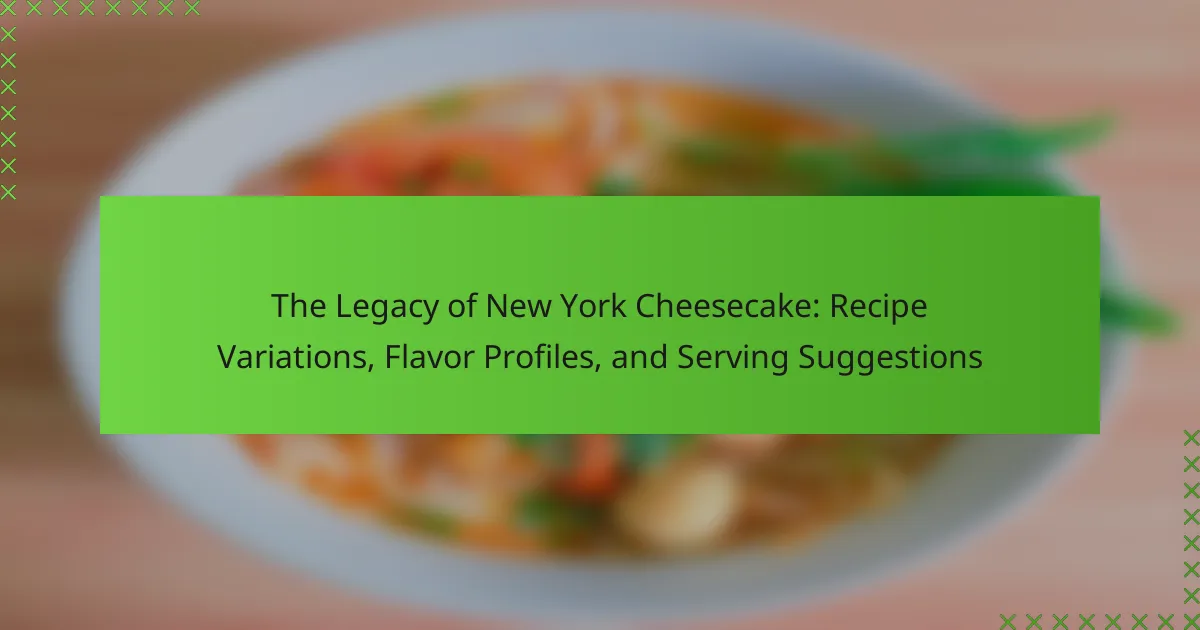
What is the Legacy of New York Cheesecake?
The legacy of New York cheesecake is rooted in its rich, creamy texture and distinctive flavor. Originating in the early 20th century, it became a staple in New York City diners and restaurants. New York cheesecake is characterized by its use of cream cheese, which gives it a unique density and richness. This dessert has influenced various adaptations and inspired other cheesecake styles worldwide. The classic version is often served plain or topped with fruit, showcasing its versatility. Its popularity is evident in numerous recipes and variations that have emerged over the years. New York cheesecake remains a symbol of American dessert culture, celebrated for its indulgent taste and iconic status.
How did New York Cheesecake originate?
New York Cheesecake originated in the early 20th century in New York City. It is believed to have been influenced by traditional European cheesecakes, particularly those from Greece and Italy. The introduction of cream cheese in the United States in the late 1800s played a crucial role in its development. Cream cheese became a key ingredient, giving the cheesecake its rich and creamy texture.
The first documented recipe for New York-style cheesecake appeared in a cookbook published in 1929. This recipe highlighted the use of cream cheese, sugar, eggs, and a graham cracker crust. Over time, New York Cheesecake gained popularity and became a staple dessert in many restaurants and homes. Its unique flavor and texture set it apart from other cheesecake varieties.
What historical influences shaped its development?
The development of New York cheesecake was influenced by European baking traditions, particularly from Germany and Italy. German immigrants brought their cheesecake recipes to America in the 19th century. Italian ricotta cheesecake also contributed to the texture and flavor profiles. The introduction of cream cheese in the early 20th century by William Lawrence in New York further shaped the recipe. This innovation led to a richer and creamier cheesecake, distinguishing it from other varieties. New York cheesecake became popular in restaurants and diners during the mid-20th century. Its association with New York City solidified its status as a cultural icon. The dessert has since evolved with various recipe adaptations and flavor variations.
Who were the key figures in popularizing New York Cheesecake?
Key figures in popularizing New York Cheesecake include Arnold Reuben, who is credited with creating the first version in the early 1900s. Reuben was a New York City restaurateur and owner of Reuben’s Restaurant. His cheesecake recipe gained fame and was featured in various publications. Additionally, the Lindy’s restaurant in Manhattan played a significant role in popularizing the dessert during the mid-20th century. Lindy’s cheesecake became iconic, attracting celebrities and food enthusiasts alike. These figures significantly contributed to the cheesecake’s status as a New York staple.
What are the defining characteristics of New York Cheesecake?
New York Cheesecake is characterized by its dense and creamy texture. It typically features a rich filling made from cream cheese, eggs, and sugar. The crust is usually made from graham crackers, providing a crunchy contrast. This cheesecake is often baked, resulting in a smooth surface. It is known for its rich flavor, which can be enhanced with vanilla or citrus zest. New York Cheesecake is traditionally served plain or with fruit toppings. The dessert is a staple in New York City, reflecting its cultural significance. The recipe has evolved but retains its classic characteristics, making it a beloved dessert worldwide.
How does the texture of New York Cheesecake differ from other cheesecakes?
New York cheesecake has a dense and creamy texture, distinguishing it from other cheesecakes. This texture results from the use of cream cheese as the primary ingredient. Other cheesecakes, like ricotta or no-bake varieties, tend to be lighter and fluffier. The baking method also contributes to New York cheesecake’s firmness. It is baked at a low temperature for a longer duration. This process allows moisture to evaporate slowly, enhancing its rich consistency. In contrast, other cheesecakes may incorporate whipped cream or gelatin, leading to a softer texture. The unique combination of ingredients and baking technique solidifies New York cheesecake’s characteristic mouthfeel.
What ingredients are essential for an authentic New York Cheesecake?
Essential ingredients for an authentic New York Cheesecake include cream cheese, sugar, eggs, sour cream, and a graham cracker crust. Cream cheese is the primary base, providing the characteristic rich and creamy texture. Sugar adds sweetness, balancing the tanginess of the cream cheese. Eggs act as a binder, giving the cheesecake its structure. Sour cream enhances the flavor and adds creaminess. Lastly, the graham cracker crust offers a crunchy contrast to the smooth filling. These ingredients are fundamental to achieving the classic taste and texture associated with New York Cheesecake.
Why is New York Cheesecake considered iconic?
New York Cheesecake is considered iconic due to its rich, creamy texture and unique flavor. This dessert is characterized by a dense filling made primarily from cream cheese. The crust typically consists of graham cracker crumbs, which adds a crunchy contrast.
New York Cheesecake’s origins trace back to the early 20th century. It gained popularity in New York City, where it became a staple in local diners and bakeries. The cheesecake’s distinct taste comes from the use of high-quality ingredients, including fresh cream cheese and sour cream.
Culinary experts often cite its balance of sweetness and tanginess as a reason for its iconic status. Additionally, the dessert has become synonymous with New York culture, often featured in films and television. The combination of its unique attributes and cultural significance solidifies New York Cheesecake’s place as a beloved dessert.
What cultural significance does it hold in New York City?
New York cheesecake holds significant cultural importance in New York City. It represents a blend of culinary traditions, particularly from Italian immigrants. The dessert has become an iconic symbol of New York’s diverse food landscape. Many famous establishments, like Junior’s, have popularized this dessert. New York cheesecake is often featured in celebrations and gatherings, reflecting the city’s communal spirit. It also plays a role in the city’s identity, often associated with its vibrant culinary scene. The cheesecake’s rich and creamy texture has earned it a loyal following among locals and tourists alike. This dessert continues to be a staple in New York’s restaurants and bakeries, showcasing the city’s love for indulgent treats.
How has it influenced dessert trends in other regions?
The New York cheesecake has significantly influenced dessert trends in various regions. Its creamy texture and rich flavor have inspired local variations worldwide. For example, in Italy, the classic ricotta cheesecake has been adapted to resemble its New York counterpart. In Japan, a lighter, soufflé-style cheesecake emerged, showcasing the influence of New York’s style. Additionally, many bakeries globally now offer fusion desserts, combining cheesecake with local flavors. This trend reflects the New York cheesecake’s versatility and global appeal. The increase in cheesecake-flavored products, like ice creams and pastries, further demonstrates its impact on dessert culture.

What are the Recipe Variations of New York Cheesecake?
Classic New York cheesecake variations include sour cream, ricotta, and heavy cream. Each variation alters the texture and flavor profile. Sour cream adds a tangy richness. Ricotta creates a lighter, fluffier consistency. Heavy cream results in a creamier texture. Additional variations feature flavors like chocolate, pumpkin, and fruit. Chocolate cheesecake incorporates melted chocolate into the batter. Pumpkin cheesecake blends pumpkin puree and spices for a seasonal twist. Fruit variations often include berries or citrus zest for added freshness. Each recipe reflects personal preferences and regional influences.
What are the most popular variations of New York Cheesecake?
The most popular variations of New York Cheesecake include chocolate, strawberry, and pumpkin flavors. Chocolate New York Cheesecake features a rich chocolate layer or swirl. Strawberry variation often incorporates fresh strawberries or strawberry sauce on top. Pumpkin New York Cheesecake is especially popular during the fall, blending traditional cheesecake with pumpkin puree and spices. Each variation maintains the classic creamy texture of a New York Cheesecake while introducing unique flavors. These variations cater to different taste preferences and seasonal occasions.
How do fruit toppings alter the flavor profile?
Fruit toppings significantly enhance the flavor profile of desserts like New York cheesecake. They introduce contrasting sweetness and acidity, balancing the rich creaminess of the cheesecake. For instance, berries add tartness, while tropical fruits offer vibrant sweetness. Citrus fruits can provide a refreshing zing, brightening the overall taste. Each fruit type contributes unique flavors and aromas, creating a complex taste experience. The combination of these elements can elevate a simple dessert into a gourmet treat. Various studies show that flavor interactions can influence consumer preferences, making fruit toppings a popular choice.
What are the differences between baked and no-bake variations?
Baked variations of cheesecake are cooked in an oven, leading to a denser texture. No-bake variations are set using refrigeration, resulting in a lighter consistency. Baked cheesecakes often include eggs, which contribute to their firmness. In contrast, no-bake cheesecakes typically use cream cheese and whipped cream for a smoother mouthfeel. Baked versions require a water bath to prevent cracking, while no-bake types do not need this method. Additionally, baked cheesecakes usually take longer to prepare due to cooking time. No-bake cheesecakes can be made quickly, often in under an hour. These differences influence flavor profiles, with baked cheesecakes having a richer taste compared to the freshness of no-bake options.
How can you customize a New York Cheesecake recipe?
You can customize a New York Cheesecake recipe by altering its crust, filling, and toppings. For the crust, consider using graham crackers, Oreo cookies, or even nut-based crusts. Changing the filling can involve adding flavors like vanilla, lemon zest, or chocolate. You can also incorporate fruit purees or extracts for unique tastes. Toppings can be varied with fresh fruits, chocolate ganache, or caramel sauce. Each modification allows for a different flavor profile, enhancing the traditional cheesecake experience. These variations are popular among home bakers and professional chefs alike, showcasing the versatility of the New York Cheesecake.
What alternative ingredients can be used for dietary restrictions?
Alternative ingredients for dietary restrictions include dairy-free cream cheese and nut-based crusts. Dairy-free cream cheese is suitable for lactose intolerance and vegan diets. It can be made from cashews or tofu. Nut-based crusts, like almond or pecan, replace traditional graham cracker crusts. These options cater to gluten-free diets. Additionally, sweeteners like maple syrup or agave can replace refined sugar. These alternatives maintain flavor while accommodating various dietary needs.
How do different crust options affect the overall taste?
Different crust options significantly affect the overall taste of New York cheesecake. A graham cracker crust provides a sweet, slightly nutty flavor that complements the creamy filling. Chocolate cookie crusts introduce a rich, decadent taste, enhancing the dessert’s indulgence. Nut-based crusts, such as almond or hazelnut, add a unique crunch and earthy notes. Each crust type influences the balance of sweetness and texture in the cheesecake. The choice of crust can elevate or alter the flavor profile, making it crucial for recipe variations. Studies in culinary arts emphasize that crust texture impacts mouthfeel and overall enjoyment.

What are the Flavor Profiles of New York Cheesecake?
New York cheesecake has a rich and creamy flavor profile. It is characterized by a tangy sweetness from cream cheese. The crust typically adds a buttery, slightly salty contrast. Vanilla extract enhances the overall flavor with warmth. Lemon zest or juice can provide a refreshing brightness. The texture is dense yet smooth, contributing to its indulgent experience. The balance of tanginess and sweetness is crucial for its signature taste. Often, it is served plain or topped with fruit or chocolate, adding additional flavor layers.
What flavors are commonly paired with New York Cheesecake?
Common flavors paired with New York Cheesecake include fruit, chocolate, and caramel. Fresh strawberries and blueberries are popular choices. These fruits add a refreshing contrast to the rich cheesecake. Chocolate sauces or ganache provide a decadent touch. Caramel drizzle enhances sweetness and adds complexity. Citrus flavors, like lemon or orange, can brighten the dish. Nut flavors, such as almond or hazelnut, also complement the creamy texture. These pairings enhance the overall flavor experience of New York Cheesecake.
How do chocolate and caramel enhance the cheesecake experience?
Chocolate and caramel enhance the cheesecake experience by adding rich flavors and contrasting textures. The smoothness of chocolate complements the creamy texture of cheesecake. Caramel introduces a sweet, buttery flavor that balances the tanginess of the cheese. Together, they create a multi-layered taste profile. This combination appeals to a wide range of palates. Studies show that flavor pairings can elevate dessert satisfaction. A survey by the Institute of Culinary Education found that chocolate and caramel are among the most popular cheesecake toppings. Their inclusion can transform a traditional cheesecake into a gourmet dessert.
What role do spices play in flavoring New York Cheesecake?
Spices enhance the flavor profile of New York Cheesecake significantly. Common spices used include cinnamon, nutmeg, and vanilla. Cinnamon adds warmth and depth, while nutmeg provides a subtle earthiness. Vanilla extract is essential for a rich, sweet aroma. These spices contribute to the overall balance of sweetness and creaminess. Their inclusion can elevate the dessert from simple to complex. Many recipes incorporate these spices to create a unique twist. This practice is rooted in culinary tradition, where spices are used to enhance desserts.
How can you create unique flavor combinations for New York Cheesecake?
To create unique flavor combinations for New York Cheesecake, incorporate various ingredients into the batter. For instance, adding citrus zest such as lemon or orange enhances brightness. Another option is to mix in extracts like almond or coconut for depth. You can also experiment with spices, such as cinnamon or nutmeg, for warmth.
Incorporating fruit purees, like raspberry or mango, can add a refreshing twist. Additionally, consider using chocolate or caramel swirls for richness. For a savory touch, ingredients like herbs or spices can be included.
The versatility of New York Cheesecake allows endless possibilities for flavor innovation. Many bakers have successfully combined these elements to create distinct desserts.
What are some innovative flavor ideas to try?
Innovative flavor ideas for New York cheesecake include matcha green tea, lavender honey, and salted caramel. Matcha adds a unique earthy taste and vibrant color. Lavender honey introduces floral notes, enhancing the dessert’s aroma. Salted caramel provides a sweet and savory contrast, appealing to diverse palates. Other options are chocolate espresso, pumpkin spice, and raspberry lemon. Chocolate espresso combines rich chocolate with coffee for a decadent experience. Pumpkin spice offers a seasonal twist with warm spices. Raspberry lemon balances tartness with sweetness, creating a refreshing flavor profile. Each of these flavors expands traditional cheesecake boundaries, attracting adventurous dessert lovers.
How do seasonal ingredients influence flavor choices?
Seasonal ingredients significantly influence flavor choices by aligning with the natural availability of produce. Fresh fruits and vegetables peak in flavor during their harvest seasons. For example, strawberries in spring and pumpkins in autumn add distinct tastes to recipes. Chefs often incorporate these ingredients to enhance freshness and authenticity. The use of seasonal ingredients can evoke nostalgia and cultural significance. They also allow for creativity in flavor combinations, as chefs adapt recipes to highlight these ingredients. Seasonal cooking promotes sustainability by reducing reliance on out-of-season imports. This approach can lead to more vibrant and memorable flavor profiles in dishes.

What are the Serving Suggestions for New York Cheesecake?
New York cheesecake can be served in various delightful ways. It pairs well with fresh fruit toppings like strawberries, blueberries, or raspberries. A drizzle of chocolate or caramel sauce enhances its rich flavor. Whipped cream is a classic accompaniment that adds lightness. For a gourmet touch, serve it with a berry compote or fruit coulis. A sprinkle of graham cracker crumbs on top can provide texture. Coffee or espresso is an excellent beverage pairing, complementing the cheesecake’s richness. Additionally, serving it chilled allows the flavors to meld beautifully. These suggestions highlight the versatility of New York cheesecake in enhancing the dining experience.
What are the best accompaniments for serving New York Cheesecake?
Fresh fruit toppings are the best accompaniments for serving New York Cheesecake. Strawberries, blueberries, and raspberries enhance the dessert’s flavor. Their acidity balances the richness of the cheesecake. Additionally, fruit sauces like berry coulis or caramel add sweetness. Whipped cream is another popular choice. It provides a light texture that complements the dense cheesecake. Chocolate shavings or nuts can also be used for added texture. These accompaniments are commonly used in restaurants and home settings alike.
How do sauces and garnishes enhance the presentation?
Sauces and garnishes significantly enhance the presentation of dishes. They add color, texture, and visual appeal. A well-placed sauce can create contrast and highlight the main components. Garnishes, such as fresh fruits or herbs, provide freshness and vibrancy. These elements can elevate the dining experience by making the dish more inviting. Research indicates that visually appealing food can increase appetite and enjoyment. In culinary arts, presentation is crucial for first impressions. Overall, sauces and garnishes play a vital role in enhancing the aesthetic quality of dishes.
What beverages pair well with New York Cheesecake?
Coffee, tea, and dessert wines pair well with New York cheesecake. Coffee complements the richness of the cheesecake. A light roast enhances the flavors without overpowering them. Tea, particularly Earl Grey or chai, adds aromatic notes that balance the dessert’s creaminess. Dessert wines like Sauternes or late-harvest Riesling provide sweetness that matches the cheesecake’s flavor profile. These beverages enhance the overall tasting experience.
What are some tips for serving New York Cheesecake at events?
Serve New York Cheesecake chilled for the best flavor and texture. Cut it into small, even slices for easy serving. Use a warm knife to achieve clean cuts. Offer a variety of toppings like fruit, chocolate, or caramel to enhance presentation. Provide plates and forks for convenience. Consider individual servings in cups for a modern touch. Ensure the cheesecake is at room temperature for optimal taste if it has been refrigerated. Lastly, label the cheesecake and toppings to inform guests about flavors and ingredients.
How can you ensure the cheesecake maintains its quality during serving?
To ensure the cheesecake maintains its quality during serving, keep it chilled until serving time. Cheesecake is best served cold, as this preserves its creamy texture. Use a sharp knife to slice the cheesecake, preventing crumbling. Wipe the knife with a warm cloth between cuts for clean slices. Serve individual portions on chilled plates to maintain temperature. Avoid leaving the cheesecake out for extended periods. Cheesecake can spoil if left at room temperature for more than two hours. Proper storage and serving techniques help maintain its flavor and texture.
What are common presentation styles for New York Cheesecake?
Common presentation styles for New York Cheesecake include serving it plain, with fruit toppings, or garnished with chocolate or caramel. A plain cheesecake highlights its creamy texture and rich flavor. Fruit toppings often include strawberries, blueberries, or cherries, adding color and freshness. Chocolate or caramel drizzles provide a decadent touch. Cheesecake can also be presented in individual portions, such as mini cheesecakes or cheesecake jars. These styles enhance the visual appeal and cater to different serving occasions.
The main entity of this article is New York cheesecake, a dessert known for its rich, creamy texture and unique flavor. The article explores the legacy of New York cheesecake, detailing its origins, historical influences, and key figures who popularized it. It discusses defining characteristics, essential ingredients, and various recipe variations, including popular flavors and toppings. Additionally, serving suggestions and beverage pairings are provided, highlighting the cultural significance and global influence of this iconic dessert.
